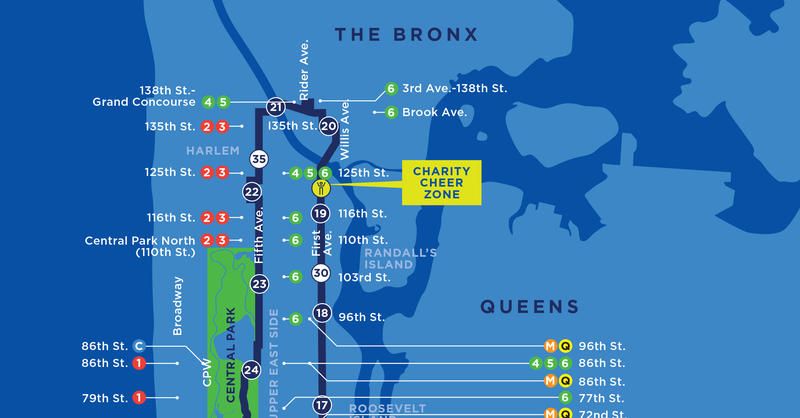100th Anniversary Great Nave Tour at the Cathedral of St. John the Divine
Celebrate the 1925 construction of the stunning nave inside the world's largest Gothic cathedral!


 Partial map of the TCS New York City Marathon
Partial map of the TCS New York City Marathon
[This article has been updated to reflect the 2019 race]
On November 3rd, 2019 the annual TCS New York City marathon will be held. The name comes from Tata Consulting Services, a sponsor for the next several years (following the ING Sponsorship). The 26.2-mile tour through the five boroughs has been held on the first Sunday in November since 1970. Stricter security measures have been taken after the events of the Boston Marathon in April 2013, and even more so after the terror attack in Downtown Manhattan in 2017, but runners from around the world have still come to complete this iconic race. We were curious to find out who decided the course of the race and did some digging to find these cool facts about the history of the NYC Marathon.
For the first official NYC Marathon took place in 1970, only about a hundred spectators watched the race, which consisted of a repeated loop around Central Park. But before that, the first marathon in the New York metropolitan area took place in Yonkers in 1907. The 1908 Olympics sparked a flurry of marathon interest and according to NYC Parks, “In 1908, the New York Evening Journal sponsored what appears to have been the first marathon run on New York City streets” on December 26th. The race began in Rye in Westchester into Pelham Bay Park, crossing the Hutchinson, down Fordham Road to Jerome Avenue, over the Harlem River using the Macomb’s Dam Bridge, down Adam Clayton Powell Boulevard to 110th Street around Central Park down Central Park West to Columbus Circle.
Marathons in 1908 and 1909 were run in the second Madison Square Garden (then still located at Madison Square Park). In 1909, there was a marathon derby in the Polo Grounds of Manhattan. A French waiter won, and we can only wonder if he was also a participant in the famous French waiter race as well. Later versions of the marathon included shorter, modified versions run between boroughs, between counties, at Coney Island, within Manhattan, and more.
But the real precursor of today’s NYC marathon was the Cherry Tree Marathon, organized by New York Road Runners which went through the Bronx. With support slowly growing in the first few years after the 1970 marathon, George Spitz was a man on a mission, proposing that the marathon go through all five boroughs. They finally gave his proposal the the thumbs up in 1976, willing to try it for only one year. Ted Corbitt writes in his essay “Willingness to Suffer” (part of the book The Spirit of the Marathon: What to Expect in Your First Marathon, and How to Run Them for the Rest of Your Life) that he was part of the team that planned the route:
In the post-World War II years, the usual site of the national marathon championship was the Yonkers Marathon course, held in May, a month after the Boston Marathon. The championship came too close after a hard run at Boston but there was nothing I could do about that. Also, Yonkers in May can be hot…Boston is known for being a downhill run on an often windblown and chilly course. On the other hand, Yonkers was known as a tough, hilly course…And the New York City Marathon course, which I helped plan, is deceptively hilly.
That year the number of spectators that came out for the race was staggering. It was a great “boom” for running in New York City and the following year, as George Hirsh writes in his NY Times City Room piece, “an entry became as hard to get as a reservation in one of the city’s hottest restaurants.”
The Marathon’s founder Fred Lebow, a runner himself, was overcome by the overwhelming response and made it his life’s work to making the marathon “bigger and better.” Hirsh writes,
Soon cities like Chicago, London and Berlin were sending emissaries to New York to learn how they might stage big urban marathons. Lebow courted the news media with gamesmanship and chutzpah. One day he told me he was going to announce a $1 million bonus to anyone running New York in under two hours. I protested that this was a ridiculous, impossible time, at least in our lifetimes, and New York was not even a fast course.
With today’s record time for men standing at 2:05:06 (set in 2011), and the women’s time at 2:22:31 (2006), runners are inching closer to this goal. It’d be interesting to find out if there is a clause in Lebow’s estate holding $1,000,000 for the person who breaks this time. Congratulations to all the runners who are competing in the marathon!
Check out the full map below:

Read more about the history of the previous 10 incarnations of the NYC Marathon. We also previously covered the 26.2 drink Marathon Day which roughly follows the course of the NYC Marathon.
Subscribe to our newsletter